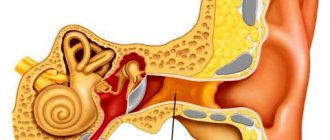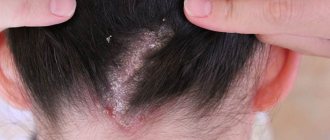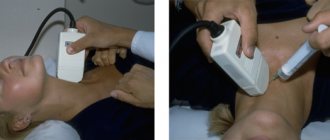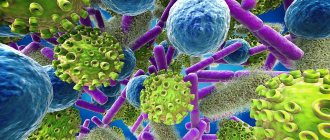Bacterial skin infections are a large group of diseases initiated by pathogenic bacteria and characterized by damage to the skin and soft tissues. They are considered one of the most common in dermatology and can be localized either on a small or large area of skin (within several hours). In terms of severity, such infections are very diverse and range from small nodules to conditions that pose a threat to the patient’s life.
The dermatovenereology department of CELT offers diagnostics and treatment for bacterial skin infections in Moscow. We have been conducting professional activities in the capital's paid medical services market for almost three decades and enjoy a good reputation. Diagnostics are carried out using modern equipment, which makes it possible to detect diseases even at the initial stages of development, and their treatment is carried out in accordance with international standards.
At CELT you can consult a dermatologist.
- Initial consultation – 3,500
- Repeated consultation – 2,300
Make an appointment
Etiology of bacterial skin infections
The most common causative agents of skin infections are staphylococci and streptococci:
| Bacterium | Description of provoked infections |
| Staphylococcus | One of the representatives of the Staphylococcaceae family, which is a gram-positive coccus. Distributed in soil and air, it can be part of the normal skin microflora of humans and animals. Pathogenic and opportunistic staphylococci, which can cause diseases, affect not only the skin, but also the nasal or oral pharynx. These species include Staphylococcus aureus, epidermal and hemolytic staphylococci, which cause eczema, psoriasis, dermatitis, and purulent lesions of the skin. They enter the body through damaged skin and hair follicles. Risk groups - patients:
|
| Streptococci | They represent a genus of ovoid or spherical gram-positive anaerobic bacteria of the Streptococcaceae family. They are parasites of humans and animals that live in the oral and nasal cavities, digestive tract and large intestine. Despite the fact that today 21 groups of streptococci have been identified, the most common are considered to be groups “A”, “D”, “F”, which parasitize the skin, neck, and nasal cavity. They enter the body through the respiratory tract and mouth. The following skin infections are caused by:
|
Treatment
Treatment of skin diseases is carried out in several stages:
- Balanced therapeutic nutrition;
- Saturation of the body with vitamins and antibiotics;
- Strengthening the overall immunity of the body;
- Powders, ointments, compresses;
- Thermal procedures;
- Ultraviolet irradiation of blood;
- Cryotherapy;
- Phytotherapy.
When the first symptoms of skin diseases appear, you should immediately consult a dermatologist.
Types of bacterial skin infections
| View | Skin infection and its features |
| Staphylococcal infections | Superficial folliculitis - characterized by inflammatory processes on the skin with a white purulent center. Most often, the infection affects the hair areas on the arms, legs and thighs, usually after hair removal carried out without observing hygiene standards. May become chronic. |
| Boils are a type of deep folliculitis, characterized by an acute purulent-necrotic inflammatory process of the follicles, sebaceous glands, and connective tissue around them. Most often, the infection is found in the cervical, occipital, femoral areas, on the back and even on the face. In the latter case, it can cause serious complications such as sepsis or meningitis. | |
| Anthrax is another type of deep folliculitis. It is a particularly dangerous infection, characterized by very rapid development and acute course. It is manifested by intoxication, inflammatory processes of the skin, lymph nodes, and internal organs. | |
| Panaritium is an infection characterized by an acute purulent process that affects the fingers of the upper and, less commonly, lower extremities. It manifests itself as pain, swelling, redness, and fever. In later stages of development, surgical intervention is required. | |
| Streptococcal infections | Erysipelas is an infection caused by group A streptococcus. It is characterized by the development of inflammatory processes of a serous or serous-hemorrhagic nature, manifesting themselves as focal lesions of bright red skin with swelling, general intoxication of the body and an increase in temperature. It is one of the most common bacterial infections. |
| Streptoderma is an infection characterized by the development of serous inflammatory processes without suppuration, severe swelling of the affected area, and the rapid formation of blisters or spots prone to peeling. | |
| Abscess - characterized by the formation of a cavity in the subcutaneous fatty tissue or muscles filled with pus. The infection manifests itself with swelling, hyperemia, and pain symptoms. |
Methods for studying skin diseases
When diagnosing skin diseases, in addition to external examination, various methods can be used to make an accurate diagnosis:
- Examination under Wood's lamp . The study uses ultraviolet rays passed through special glass. Hairs affected by different types of skin diseases will appear differently.
- Cytological examination is carried out in order to identify acantholytic cells that can cause the development of true pemphigus (pemphigus).
- Swabs are given to detect the pathogen.
- biopsy .
In addition to all this, a blood test is performed for tumor markers and identification of infections of various origins. The sooner the cause of a skin disease is identified, the sooner treatment will begin, and as a result, recovery will occur.
Herpes simplex
Herpes simplex (lichen simplex)
- most often appears as grouped blisters on a reddened area of the skin. Routes of transmission: contact (sexual) and airborne droplets. Approximately 90% of the world's population are virus carriers. However, not all of them have clinical manifestations.
At birth, antibodies are passively transferred from the mother to the child, which usually disappear by the 3rd year of life, and the child becomes susceptible to infection by the virus. Typically, in 80-90% of cases, primary infection occurs unnoticed and occurs without clinical symptoms, but sometimes pronounced manifestations of the disease are observed - primary herpes. After the disappearance of the clinical symptoms of primary herpes or after a period of its asymptomatic course, the infection passes into a latent form, when the virus is in an inactive state. At this time, antibodies to the herpes virus appear in the blood, despite the presence of which, under the influence of various provoking factors (colds, stress, hypothermia, etc.), relapses of the disease occur, the intervals between which range from several days to several months and even years. People suffering from frequent relapses of the disease, if even minimal sensations occur, can themselves predict the appearance of rashes in the near future.
The disease is characterized by the appearance of blisters on a swollen, reddened background. The blisters can persist from several hours to several days, then the blisters turn into erosions that can become crusted. Often the appearance of rashes is accompanied by itching, enlargement of lymph nodes, and their pain. Often relapses are accompanied by headache, malaise, and dysfunction of the digestive tract. In women, relapses of herpes can have a clear connection with the menstrual cycle, usually occurring before the start of each menstruation.
Shingles Shingles (herpes zoster)
- acute viral disease. It manifests itself as grouped rashes along the nerve trunks and is accompanied by neuralgic pain. Shingles is considered as a secondary infection against the background of a partial decrease in immunity, which developed as a result of contact of the body with the virus in the past. In typical cases, the disease begins with pain and itching at the site of the future localization of the rash. Quite often, rashes of herpes zoster are accompanied by general phenomena in the form of weakness, malaise, headaches, and increased body temperature.
The number of patients usually increases in spring and autumn. All viral diseases, in parallel with treatment by a dermatologist, require consultation with an immunologist.
List of contagious skin diseases
The main pathologies that are contagious include diseases such as:
- Scabies. The cause is a microscopic mite that settles on the skin. During the daytime it is at rest, and closer to night it begins to become active. The female gnaws special holes in the skin and lays eggs there. Young individuals quickly reach reproductive age and continue to reproduce.
- Pediculosis. People call this pathology lice. Small insects are transmitted through things and through personal contact.
- Microscopy. It is formed by microscopic spores of dermatophytes that can maintain their viability for up to 10 years. They easily tolerate heat and severe frosts and die only under the influence of disinfection and boiling.
In our clinic, we can carry out all the necessary diagnostic measures; after making a diagnosis, a highly qualified doctor will prescribe effective treatment.
Sources
- Weinberger KR., Kulick ER., Boehme AK., Sun S., Dominici F., Wellenius GA. Association Between Hurricane Sandy and Emergency Department Visits In New York City By Age and Cause. // Am J Epidemiol - 2021 - Vol - NNULL - p.; PMID:33910231
- Miller JE., Carter KW., de Klerk N., Burgner DP. The familial risk of infection-related hospitalization in children: A population-based sibling study. // PLoS One - 2021 - Vol16 - N4 - p.e0250181; PMID:33909680
- Herbosa CM., Bhat TS., Semenov YR., Rosman IS., Musiek AC. Diagnostic concordance of clinical diagnosis, tissue culture, and histopathology testing for skin and soft tissue infections: A single-center retrospective study. // Int J Womens Dermatol - 2020 - Vol6 - N5 - p.395-398; PMID:33898706
- Sari MK., Satria CD., Arguni E. Predictors of Infection in Children with Systemic Lupus Erythematosus: A Single Center Study in Indonesia. // Glob Pediatr Health - 2021 - Vol8 - NNULL - p.2333794X211005609; PMID:33889678
- Jones SU., Chua KH., Chew CH., Yeo CC., Abdullah FH., Othman N., Kee BP., Puah SM. spa diversity of methicillin-resistant and -susceptible Staphylococcus aureus in clinical strains from Malaysia: a high prevalence of invasive European spa-type t032. // PeerJ - 2021 - Vol9 - NNULL - p.e11195; PMID:33889447
- Chan ED., Cota-Gomez A., Podell B. Adding Another Piece to the Puzzle of Why NTM Infections Are Relatively Uncommon despite Their Ubiquitous Nature. // mBio - 2021 - Vol12 - N2 - p.; PMID:33879587
- Urie R., McBride M., Ghosh D., Fattahi A., Nitiyanandan R., Popovich J., Heys JJ., Kilbourne J., Haydel SE., Rege K. Antimicrobial laser-activated sealants for combating surgical site infections. // Biomater Sci - 2021 - Vol - NNULL - p.; PMID:33876069
- Scott MM., Liang SY. Infections in Older Adults. // Emerg Med Clin North Am - 2021 - Vol39 - N2 - p.379-394; PMID:33863466
- Lipový B., Mager R., Raška F., Hanslianová M., Blažek J., Křemečková H., Suchánek I., Hladík M. Vibrio vulnificus-Induced Necrotizing Fasciitis Complicated by Multidrug-Resistant Acinetobacter baumannii Infection: Efficacy of Chemical Necrectomy Using 40% Benzoic Acid. // Int J Low Extreme Wounds - 2021 - Vol - NNULL - p.15347346211004305; PMID:33856245
- Monecke S., Müller E., Braun SD., Armengol-Porta M., Bes M., Boswihi S., El-Ashker M., Engelmann I., Gawlik D., Gwida M., Hotzel H., Nassar R ., Reissig A., Ruppelt-Lorz A., Senok A., Somily AM., Udo EE., Ehricht R. Characterization of S. aureus/MRSA CC1153 and review of mobile genetic elements carrying the fusidic acid resistance gene fusC. // Sci Rep - 2021 - Vol11 - N1 - p.8128; PMID:33854075
Cost of consultation with a doctor?
| Name of service | Price, rub.) |
| Initial appointment with a dermatologist | 2000 rub. |
| Repeated appointment with a dermatologist | 1500 rub. |
| Primary appointment with an obstetrician-gynecologist (candidate of medical sciences; doctor of medical sciences) | 2100 rub. |
| Primary appointment with a urologist-andrologist | 2000 rub. |
| Repeated appointment with a urologist-andrologist | 1500 rub. |
| Repeated appointment with an obstetrician-gynecologist (candidate of medical sciences; doctor of medical sciences) | 1600 rub. |
| Primary appointment with an obstetrician-gynecologist | 2000 rub. |
| Repeated appointment with the obstetrician-gynecologist | 1500 rub. |
| Consultation with an obstetrician-gynecologist on pregnancy | 2500 rub. |
| Individual selection of drug treatment for diseases of the pelvic organs | from 1500 to 3000 rub. |
All our services and prices
Molluscum contagiosum
– a viral pathology that affects adults and children with weakened immune systems through direct contact. The rash appears in the genital area and perineum. In children, you can observe small pink nodules on open areas of the body, which after some time spread to closed areas. Skin formations usually do not manifest themselves in any way. Sometimes patients experience itching and slight soreness. Treatment of molluscum contagiosum involves removal in various ways: Radio wave coagulation (the most effective) with the Surgitron apparatus, electrocoagulation and laser coagulation, previously removed with tweezers. The wound site is treated with an antiseptic solution.
Herpes
can appear at any age. It causes not only a cosmetic defect and physical discomfort, but also a number of serious complications. Treatment of this disease depends on the type of herpes infection and boils down to taking medications based on acyclovir, using special ointments and gels, as well as mandatory immunomodulatory therapy. Recurrence of herpes is possible after hypothermia, overheating, past illnesses and other provoking factors, when the body’s protective functions are weakened. It can also be transmitted sexually.
Papillomas
– benign formation of a viral nature, soft or dense consistency. The color of papillomas varies from light pink to brown. The treatment regimen for the disease in each case is selected strictly individually based on the results of laboratory tests. The patient is prescribed antiviral drugs that suppress the proliferation of dangerous microorganisms, and immunomodulatory drugs. Depending on the clinical picture, it is possible to remove papillomas using radio waves, laser, liquid nitrogen or electrocoagulation. Currently, liquid nitrogen is rarely used.
Condylomas
pointed ones affect the skin, mucous membranes of the genitals, oral cavity and anal area. Infection occurs through sexual contact, and the incubation period can last several months. Externally, condylomas resemble pink nodules. Formations can be single or multiple. Merging with each other, they completely cover the affected area of the body and look like bunches of cauliflower. Treatment of the disease comes down to their mechanical or chemical removal, as well as strengthening the immune system with the help of immunomodulatory drugs.
Warts
– the most common skin diseases. Infection with this unpleasant disease occurs during contact with a sick person. Dense growths covered with a stratum corneum can be single or multiple. They can be located on any part of the body - fingers, hands, face, soles, scalp and are prone to spread. After their removal, new formations may appear. Often, in people with good immunity, the disease goes away on its own, but it is recommended to immediately contact a specialist to prescribe the correct treatment and not wait for the disease to subside. Self-medication can cause the appearance of scars, as well as injury and bleeding of warts. The main method of combating the disease is to remove or destroy formations using radio wave coagulation (Surgitron), laser, electrocoagulation, cryodestruction with liquid nitrogen or through surgery.
Sign up for treatment for viral skin diseases
Make an appointment










